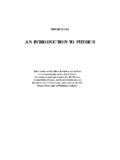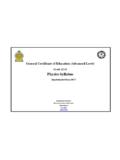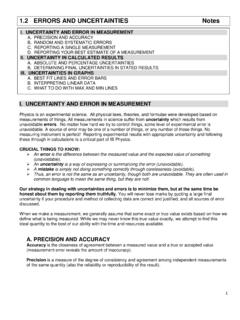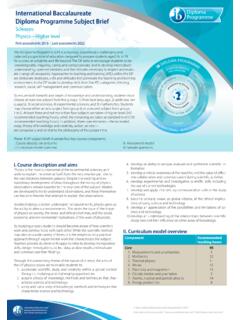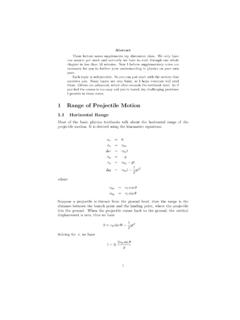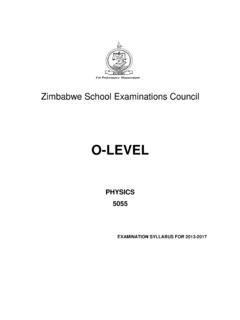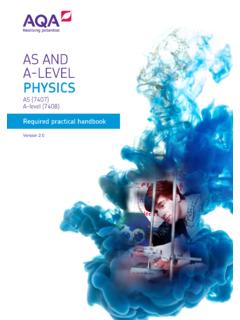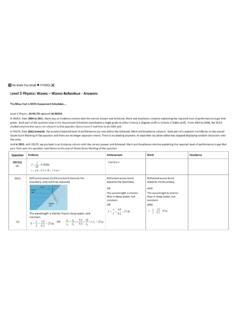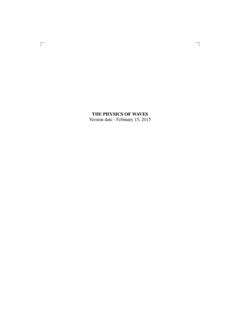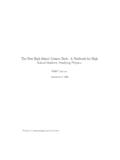Transcription of AN INTRODUCTION TO PHYSICS
1 PHYSICS 101 AN INTRODUCTION TO PHYSICS This course of 45 video lectures, as well as accompanying notes, have been developed and presented by Dr. Pervez Amirali Hoodbhoy, professor of PHYSICS at Quaid-e-Azam University, Islamabad, for the Virtual University of Pakistan, Lahore. Virtual University PHYSICS 101 Dr. Pervez Hoodbhoy 2 TABLE OF CONTENTS I. GENERAL INFORMATION II. LECTURE SUMMARIES Lecture 1 INTRODUCTION to PHYSICS and this course Lecture 2 Kinematics I Lecture 3 Kinematics II Lecture 4 Force and Newton s Laws Lecture 5 Applications of Newton s Laws I Lecture 6 Applications of Newton s Laws II Lecture 7 Work and Energy Lecture 8 Conservation of Energy Lecture 9 Momentum Lecture 10 Collisions Lecture 11 Rotational Kinematics Lecture 12 PHYSICS of Many Particles Lecture 13 Angular Momentum Lecture 14 Equilibrium of Rigid Bodies Lecture 15 Oscillations - I Lecture 16 Oscillations - II Lecture 17 PHYSICS of Materials Lecture 18 PHYSICS of Fluids Lecture 19 PHYSICS of Sound Lecture 20 Wave Motion Lecture 21 Gravitation Lecture 22 Electrostatics I Lecture 23 Electrostatics II Lecture 24 Electric Potential Lecture 25 Capacitors and Currents Lecture 26 Currents and Circuits Lecture 27 The Magnetic Field Lecture 28 Electromagnetic Induction Lecture
2 29 Alternating Current Lecture 30 Electromagnetic Waves Lecture 31 PHYSICS of Light Lecture 32 Interaction of Light with Matter Lecture 33 Interference and Diffraction Lecture 34 The Particle Nature of Light Lecture 35 Geometrical Optics Lecture 36 Heat I Lecture 37 Heat II Lecture 38 Heat III Lecture 39 Special Relativity I Lecture 40 Special Relativity II Lecture 41 Matter as Waves Lecture 42 Quantum Mechanics Lecture 43 INTRODUCTION to Atomic PHYSICS Lecture 44 INTRODUCTION to Nuclear PHYSICS Lecture 45 PHYSICS of the Sun Virtual University PHYSICS 101 Dr. Pervez Hoodbhoy 3 GENERAL INFORMATION Purpose: This course aims at providing the student a good understanding of PHYSICS at the elementary level. PHYSICS is essential for understanding the modern world, and is a definite part of its culture. Background: It will be assumed that the student has taken PHYSICS and mathematics at the level, the 12th year of schooling. However, students are also likely to find the course useful.
3 Calculus is not assumed and some essential concepts will be developed as the course progresses. Algebra and trigonometry are essential. However, for PHYSICS , the more mathematics one knows the better. Scope and Duration: The course has 45 lectures, each of somewhat less than one hour duration. All main fields of PHYSICS will be covered, together with several applications in each. Language: For ease of communication, all lectures are in Urdu. However, English or Latin technical terms have been used where necessary. The student must remember that further study and research in science is possible only if he or she has an adequate grasp of English. Textbook: There is no prescribed textbook. However, you are strongly recommended to read a book at the level of College PHYSICS by Halliday and Resnick (any edition). There are many other such books too, such as University PHYSICS by Young and Freedman. Study any book that you are comfortable with, preferably by a well-established foreign author.
4 Avoid local authors because they usually copy. After listening to a lecture, go read the relevant chapter. Please remember that these notes cover only some things that you should know and are not meant to be complete. Assignments: At the end of every lecture summary you will find a few questions that you should answer. The book you choose to consult will have many more. Those students who are seriously interested in the subject are advised to work out several of the questions posed there. In PHYSICS you cannot hope to gain mastery of the subject without extensive problem solving. Examinations: Their schedules will be announced from time to time. Tutors: Their duty is to help you, and they will respond to all genuine questions. However, please do not overload them as they have to deal with a large number of students. Happy studying! Acknowledgements: I thank the Virtual University team and administration for excellent cooperation, as well as Mansoor Noori and Naeem Shahid, for valuable help.
5 Copyright: Pervez Amirali Hoodbhoy, Professor of PHYSICS , Quaid-e-Azam University, Islamabad. Virtual University PHYSICS 101 Dr. Pervez Hoodbhoy 4 Summary of Lecture 1 INTRODUCTION TO PHYSICS 1. PHYSICS is a science. Science works according to the scientific method. The scientific method accepts only reason, logic, and experimental evidence to tell between what is scientifically correct and what is not. Scientists do not simply believe they test, and keep testing until satisfied. Just because some big scientist says something is right, that thing does not become a fact of science. Unless a discovery is repeatedly established in different laboratories at different times by different people, or the same theoretical result is derived by clear use of established rules, we do not accept it as a scientific discovery. The real strength of science lies in the fact that it continually keeps challenging itself.
6 2. It is thought that the laws of PHYSICS do not change from place to place. This is why experiments carried out in different countries by different scientists of any religion or race have always led to the same results if the experiments have been done honestly and correctly. We also think that the laws of PHYSICS today are the same as they were in the past. Evidence, contained in the light that left distant stars billions of years ago, strongly indicates that the laws operating at that time were no different than those today. The spectra of different elements then and now are impossible to tell apart, even though physicists have looked very carefully. 3. This course will cover the following broad categories: a) Classical Mechanics, which deals with the motion of bodies under the action of forces. This is often called Newtonian mechanics as well. b) Electromagnetism, whose objective is to study how charges behave under the influence of electric and magnetic fields as well as understand how charges can create these fields.
7 C) Thermal PHYSICS , in which one studies the nature of heat and the changes that the addition of heat brings about in matter. d) Quantum Mechanics, which primarily deals with the PHYSICS of small objects such as atoms, nuclei, quarks, etc. However, Quantum Mechanics will be treated only briefly for lack of time. 4. Every physical quantity can be expressed in terms of three fundamental dimensions: Mass (M), Length (L), Time (T). Some examples: 1222212 Speed Acceleration Force Energy Pressure LTLTMLTMLTMLT You cannot add quantities that have different dimensions. So force can be added to force, but force can never be added to energy, etc. A formula is definitely wrong if the dimensions on the left and right sides of the equal sign are different. Virtual University PHYSICS 101 Dr. Pervez Hoodbhoy 50 v 5.
8 Remember that any function ()fx takes as input a dimensionless number x and outputs a quantity f (which may, or may not have a dimension). Take, for example, the function () sin .f = You know the expansion: 35sin3!5! = + If had a dimension then you would be adding up quantities of different dimensions, and that is not allowed. 6. Do not confuse units and dimensions. We can use different units to measure the same physical quantity. So, for example, you can measure the mass in units of kilograms, pounds, or even in sair and chatak! In this course we shall always use the MKS or Metre-Kilogram-Second system. When you want to convert from one hsystem to another, be methodical as in the example below: 7. A good scientist first thinks of the larger picture and then of the finer details. So, estimating orders of magnitude is extremely important. Students often make the mistake of trying to get the decimal points right instead of the first digit which obviously matters the most!
9 So if you are asked to calculate the height of some building using some data and you come up with metres or 106 metres, then the answer is plain nonsense even though you may have miraculously got the last six digits right. PHYSICS is commonsense first, so use your intelligence before submitting any answer. 8. Always check your equations to see if they have the same dimensions on the left side as on the right. So, for example, from this principle we can see the equation 222222v2 is clearly wrong, whereas v13 uatu at=+=+could possibly be a correct relation. (Here v and u are velocities, a is acceleration, and t is time.) Note here that I use the word possibly because the dimensions on both sides match up in this case. 9. Whenever you derive an equation that is a little complicated, see if you can find a special limit where it becomes simple and transparent. So, sometimes it is helpful to imagine that some quantity in it is very large or very small.
10 Where possible, make a mental graph so that you can picture an equation. So, for example, a 220-( v-v ) / formula for the distribution of molecular speeds in a gas could look like (v)v. Even without knowing the value of a you can immediately see that a) (v) goes to zero foafef=0r large values of v, and v0. b) The maximum value of (v) occurs at v and the function decreases on both side of this 11 1 15280 you write it out in this manner, note that various quantities cancel out cleanly in the numerator and denominator. So mimiftmhrmhrhrmiftss= =you never make a mistake!Virtual University PHYSICS 101 Dr. Pervez Hoodbhoy 6 QUESTIONS AND EXERCISES 1 1. Scientists are told to doubt everything and not believe anything that is not provable. Is this a strength or weakness of science? 2. According to the philosopher of science, Sir Karl Popper, even the most well-established and popular scientific theory can never be proved it can only be disproved.
